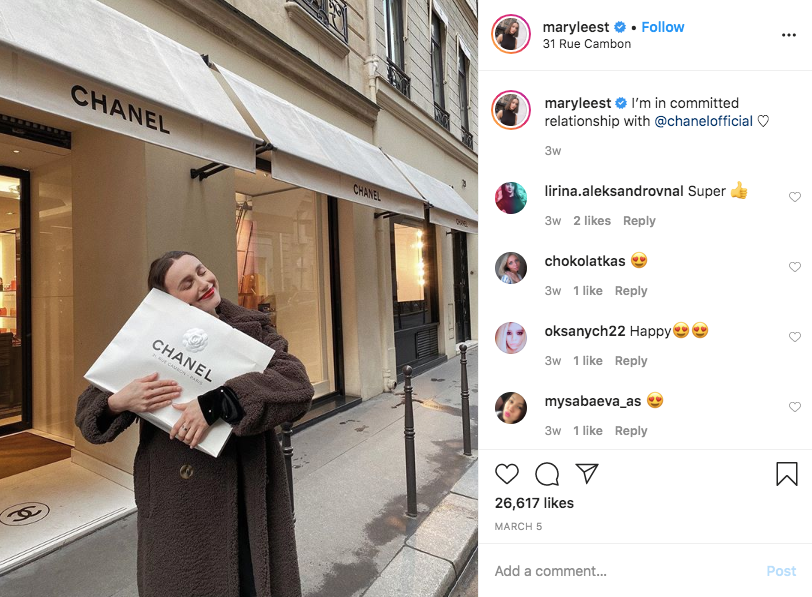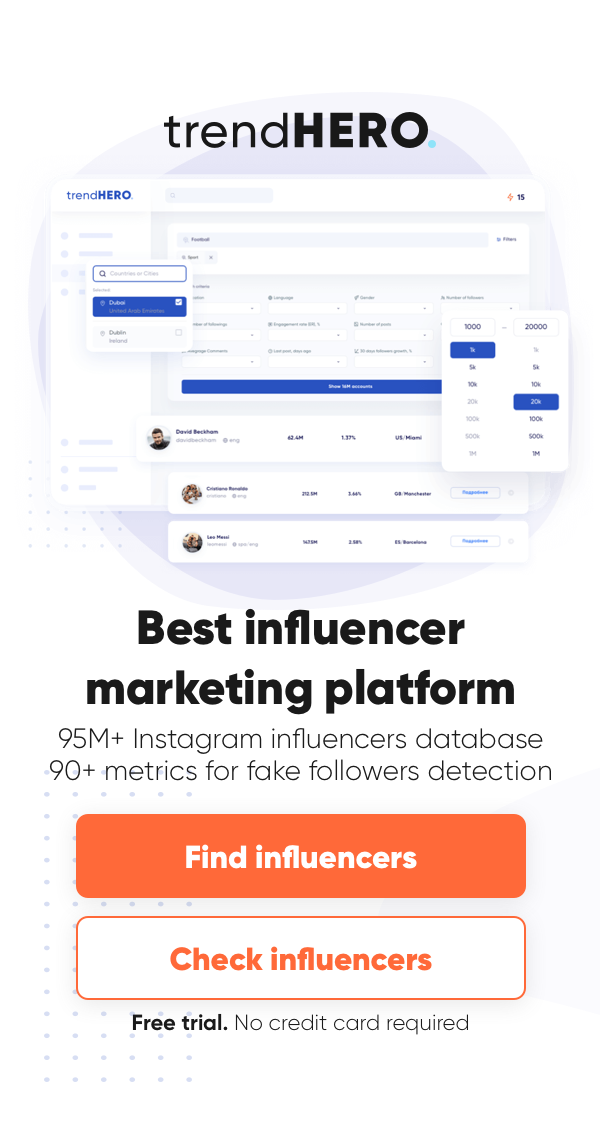- Home
- BLOG
- Influencers
- Top 20 Questions to Ask an Influencer Before You Start Working Together
Influencer marketing is all the rage now, and it’s no news to any marketer who knows their job. So in most cases, when it comes to questions like “Should I engage influencers in my marketing campaign?” the answer is obvious. But before you start, it’s important to make sure that the blogger you’ve chosen is the right one for you. How do you do that? Well, one of the ways is preparing all the important questions to ask an influencer and analyzing the answers.
But why does it make so much sense to partner with bloggers on popular social platforms? There are multiple reasons for that:
- People tend to see influencers as significant people in their lives and give a lot of credence to their recommendations.
- This high level of trust people put in a content creator extends to brands they advertise.
- Even short-term marketing campaigns involving bloggers offer long-term effects.
- Great target audience coverage. In just a few hours, a top blogger can deliver information about your brand to thousands of subscribers.
- This attracts new followers and subs to your social media accounts.
You see, classic methods of advertising become increasingly outdated. With the modern world’s fast-paced digitalization, digital marketing gets more and more relevant. People tend to trust people and not corporate entities. They would much rather take heed of some tips and advice given by an influential blogger than believe in another generic TV commercial.
That’s why content creators rapidly take over the areas of influence previously occupied by traditional media. And there are plenty of recent studies confirming that influencer marketing trend is going to grow. For example, did you know that over 50% of marketers believe that influencer content is more effective than their own corporate content? Or that 87% of customers were motivated to buy products after an influencer recommended them?
But it’s not just any blogger that will make your marketing campaign work. Before giving a start to a partnership, there are many factors to consider. And the very first thing you’d want to do after contacting an influencer is asking questions. This will help you understand if the whole deal is worth the trouble and help you avoid painful mistakes later on.
What are the most important questions to ask an influencer?

1. What type of content do you produce?
Now, this might sound like a silly question. After all, you can easily see the type of content an influencer creates as soon as you open their profile page. However, you might be surprised to know that their vision of their own content and the way it looks to an outsider are sometimes different things. In some cases, their content might look like something your target audience enjoys, but it doesn’t have a clear common theme.
You as a marketer want to partner with someone who has a very clear idea of what kind of content they want to and are ready to produce. What’s more, this idea must match your brand’s identity and mission.
?What you want to hear:
It would be great if your potential influencer partner can clearly explain what their content is about. Their answer must reflect a clear understanding of what kind of content they produce, who they produce it for, and why. It would be ideal if they can fit all that into a couple of sentences.
?Red flags:
- an influencer finds it hard to describe what type of content they create;
- they go into a longwinded, wordy and vague explanation that doesn’t offer any clear picture;
- they seem undecided if they want to keep working with this type of content in the future.
2. What is your target audience?
Again, you’d be surprised how many bloggers have no idea what their target audience is. Some of them just keep making content because they think it’s trendy. More often than not, they work that trend to death. Do I have to explain that this leads to a disinterested audience? And the disinterested, tired audience is something you want to avoid like the plague.
In the meantime, for any influencer who knows what they are doing, their blog is a kind of business. And as we all well know, any business starts with customers and their needs, desires, and issues. Sure, it would be wrong to say that many bloggers have the perfect knowledge of their target audience at the start of their careers. However, those who do want to grow, take special care to learn more about their following by interacting with subscribers and delivering engaging content.
?What you want to hear:
Your potential partner shows a good understanding of who they talk to, how they talk when they talk, and why. They care more about the quality of their audience, not quantity. They like to interact with their community. They know what their subscribers enjoy and what they aren’t too thrilled about. They are well aware of their TA age, geography, social status.
?Red flags:
- an influencer is uncertain about what target audience really is;
- they say they don’t care about target audiences because their content is for everyone;
- they claim they create content for several target audiences;
- they don’t know and/or don’t care where the majority of their following is from geographically.
3. Can you provide information on your profile metrics?

There can be no two opinions about it: any blogger who cares about their social media career cares about their profile stats. There is also little doubt that someone who is confident about their audience quality would have any difficulty sharing those stats. Unless they are not interested in any partnerships, but it’s not what we are talking about here.
One of the major metrics you want to pay attention to is Engagement. Engagement shows how active a blogger’s following is. In short, it’s all the likes, comments, saves, views, reposts, etc. What you want to look for first of all are comments and reposts. These usually require a certain amount of effort from subscribers, while likes are too easy to cheat with.
Sure, there are places you can get social profile stats and metrics from without asking a blogger to provide them. But this is a good way to learn just how much an influencer cares about their content effectiveness. And if they are prepared to be open and truthful about their stats.
?What you want to hear:
Ideally, it would be great to receive detailed analytics on engagement rate, subscriber age and geography, audience coverage. For example, Instagram has in-built analytics tools that show rather detailed statistics on multiple parameters. So there is no reason for a blogger to have any difficulty showing those stats to you, unless they have something to hide.
?Red flags:
- they seem unwilling to provide you with the most basic profile metrics;
- they aren’t sure how to use social profile analytics tools;
- they offer analytics screenshots that were clearly tampered with
4. Have you heard about my brand and if so, what do you think about it?
Sure, it’s great if an influencer is familiar with the products your brand offers, tried them, and liked them. This would add authenticity to all sponsored content they produce. And authenticity is a must for a successful marketing campaign. However, if they never used your products and are unfamiliar with them, it’s not a reason to forget about your budding partnership. After all, it’s a great chance to make them fall in love with what you have to offer – and make their audience love it too.
Let them express their own opinion on your business and your products. Take note of the words they use to support their point of view. This will give you some idea of just how well your marketing campaign goals match the influencer’s mindset.
?What you want to hear:
An honest answer, of course. Anyone can do a Google search, but what you want is a fair and detailed personal opinion. Not just praise; some constructive criticism should be very welcome to you as a marketer. Besides, it means that a blogger you are talking to takes it seriously. After all, what you want from them is genuine recommendations to your TA and not outright blandishment.
?Red flags:
- they give you very basic information about your brand and assure you they love your products, but have difficulty to explain why;
- they confuse your products with some other brands.
5. Did you partner with similar brands before?
Trust me, you are not the only marketer who has ever favored a social platform or two in the hope to capitalize on influencer marketing. If an influencer has a substantial following, chances are they’ve already received a few partnerships offers from other brands. What’s more, it’s quite likely those offers were from brands that operate in the same market niche. And there is nothing wrong with that. Just the contrary, in fact; experience might be a great bonus.
If they did work with similar brands in the past, ask for some details of those collaborations. What type of partnership was it? How long did it last? View the sponsored posts and analyze the stats. You could use some aspects of their marketing campaign to your advantage. Or at least you could get some idea of what you would want to do differently with yours.
?What you want to hear:
As always, honesty is the best policy. Let them tell you as much as they can about any experience they had with brands with similar lines of products. It would be great if they could offer an analytics report. In case they had no such experience, make sure to ask if they ever received offers from other brands like yours. And if they did, it would be great to know why they didn’t accept them.
?Red flags:
- they seem unwilling to disclose details on their partnerships with other brands;
- the analytics reports from previous partnerships they provide you with and your own analysis have discrepancies;
- they’ve turned down all partnership offers from similar brands.
6. How often do you post sponsored content?

Once again, it’s likely they did this before. Even if they don’t have a huge subscriber base, it’s possible other companies partnered with them at some point. They might be even partnering with some businesses at the moment. And it’s not a problem of itself unless they post sponsored content every other day. You definitely don’t want your brand’s marketing campaign to drown in the sea of similar ones. Besides, the more advertising there is, the less trust their audience has for it.
You want to look for influencers who had some experience partnering with brands before. It’s preferable that they are not in a partnership now. Or that they are partnering with a different brand that doesn’t operate in your market niche.
?What you want to hear:
You certainly want them to mention all paid collaborations they are in at the moment. Sure, you can (and should) check how much of sponsored content pops up on their profile weekly. But you would want to hear it from them directly. What kinds of partnerships are they taking part in at present? How much of sponsored content do they produce on a regular basis?
?Red flags:
- they hold back some or all information about their ongoing paid partnerships;
- they already collaborate with several brands that sell products similar to yours;
- they bombard their audience with sponsored content.
7. Are you comfortable with the format and type of content our marketing campaign requires?
I’ll give it to you straight. If an influencer’s content is different from what you want your marketing content to look like, choose another blogger. The reason is simple. If sponsored content stands out and becomes obvious, you can forget about authenticity. They will see it for what it is – ads – and stop putting any trust in it.
This is why it always makes sense to give your potential partner a detailed explanation of what format and type of content you are expecting. Let them consider it carefully and let you know how well they match the type of content they produce on a regular basis. Believe me, this is one of those things you’d want to be discussed long before your partnership starts. Make sure you and your influencer are on the same page.
?What you want to hear:
Once again, some honesty. Is what you want from them different from what they already produce? Ask them to explain why exactly they don’t mind working with your specific format. Let them express any doubts and ask all the questions they want to make your wishes perfectly clear.
?Red flags:
- they inform you they are comfortable with any format;
- they are eager to drastically change the type of content they produce to partner with you.
8. How can you organically integrate our sponsored content in your profile?

Once you’ve made sure you are both on the same page when it comes to content format, it’s time for a followup question. You see, if the way their content looks is somewhat different from your vision, it’s not a major problem. There is always a chance to discuss the ways to make sponsored content look as organic and authentic as possible.
Let them give you their suggestions. Their ideas might help those sponsored posts look more interesting and motivating than you saw in your mind’s eye. In any case, you can always reach a certain compromise that will satisfy you both. On the one hand, you’ll get the marketing campaign you planned as you planned it. On the other hand, they won’t have to sacrifice their originality for a partnership.
?What you want to hear:
Let them come up with their own ideas. Let them ask questions. Let them offer a few suggestions, maybe even show examples of how they see it. It’s always a great sign if they are open to discussion and can offer interesting solutions.
?Red flags:
- they often ask for your opinion but don’t seem to be able to come up with many ideas of their own;
- they never ask any questions at all;
- they passively wait for you to give them ideas.
9. Do you think you can work in accordance with all of our guidelines?
Collaborations with influencers are business partnerships, there can be no doubt about that. And like all business partnerships, they follow certain rules. The best way to start a partnership discussion is to make sure your partner is capable of following these rules.
Don’t get me wrong. It’s never a good idea to create rigid frameworks for content creators. There must always be a chance for creativity and out-of-the-box thinking. Otherwise, your marketing campaign won’t look any different from any boring ad campaign everyone is sick and tired of.
That being said, guidelines are there for a reason. For your marketing campaign to be successful, sponsored content must show up where you want it and within the timeframes planned. Your communication must not be hampered; all messages must always be answered in a timely manner. Complying with these and some other guidelines is crucial for this kind of partnership.
?What you want to hear:
If they are sincerely interested in partnering with you, they will answer your questions on time. Let them take special care to make sure there are no miscommunications of any kind. Promises are great, but let them show you just how prepared they are to meet all deadlines and requirements.
?Red flags:
- it takes too long for them to respond to your messages;
- they often ‘forget’ answering important questions you’ve got for them;
- they don’t offer any alternate ways to contact them in case you can’t reach them via email or PMs.
10. Are you willing to discuss your content before posting it?

This question is especially important if you’re about to partner with an influencer who has never been in a collaboration before. It makes sense even if you discussed the type of content you want to see on their profile a million times. When you want your marketing to work, you make sure that the quality of content is just as you want it. Factual or spelling mistakes, broken links, wrong formatting, wrong visual content. All these errors, however small, might turn your target audience away from your brand. Make sure that your potential partner fully realizes this.
Let them know it’s not about distrusting their competence or judgment. Discussing smaller details before letting the content go live is normal practice. Besides, you don’t have to do it all the time during the entire course of your partnership. Once you make sure your chosen content creator gains some experience, you can let them post the sponsored content without sharing it with you beforehand.
?What you want to hear:
Readiness to share, discuss, and adjust content at any stage of your partnership is something that should always be there.
?Red flags:
- they are not willing to share their content before posting even though they don’t have much experience;
- they fail to let you know when they let the content go live;
- they meet your suggestion to discuss sponsored posts before they go public with resentment.
11. How do you feel about brainstorming content ideas and concepts?

It doesn’t matter how experienced an influencer is in paid collaborations. It doesn’t matter how many subscribers they have. Teamwork is always an extremely important part of this type of business relationship. The more you work together on creating the best content possible the better.
This is what collaboration is all about. The best ideas are born when you work on them together. The result of such teamwork is not just content that satisfies both a marketer and a content creator. It’s also a higher level of audience engagement which in turn leads to a higher level of trust for your brand.
?What you want to hear:
If there’s no obvious desire to work cooperatively to increase the effectiveness of this partnership, it’s not worth the trouble. Give them a chance to offer their own ideas, as well as to discuss those you have in mind.
?Red flags:
- the desire to come up with any ideas is near to non-existent;
- they are unwilling to take part in any brainstorming sessions;
- they offer no original ideas of their own and feel comfortable with just using yours.
12. What type of collaborations do you prefer?
While some bloggers prefer paid collaborations only, others are more than happy to agree to a barter collaboration. There is no perfect way, each blogger chooses what they are most comfortable with at the moment.
More often than not content creators just include a mention of a brand name in their posts. But of course, there are many other options, such as:
- reviews;
- promo code discount offers;
- contests and/or giveaways.
The choice depends on your marketing campaign goals. Discount offers and reviews boost sales, while contests and giveaways boost brand awareness and TA loyalty.
The type and format of collaborations is something that must be discussed straight away. You don’t want any miscommunications where the money is concerned.
?What you want to hear:
Just let them offer their vision of how they see this collaboration happening. Needless to say, when it comes to compensation (and its amount and nature), it’s important to stay within reason and apply common sense.
?Red flags:
- an influencer wants to have it all and immediately;
- they have a history of cheating with contests and giveaways.
13. How much do you charge per a sponsored post?
Fortunately or not, this is not the case when you can get a price list with all the prices set in stone. Each blogger might have their own idea of what their fees must be. These fees can be based on their number of subscribers, audience quality, and/or the size of their ego. The kind of content they create and its level of popularity have some significance too. The usual rule of a thumb for Instagram bloggers says that you should pay a thousand US dollars per 100, 000 subscribers. But you might end up paying more or less depending on many factors.
The good news is you can always discuss prices and come to a mutually beneficial agreement. However, make sure that you don’t spend the entire marketing budget on a single influencer. Another important thing is to ask them whether they offer discounts for long-lasting partnerships.
Many micro-influencers are often ready to get a free product as a way of payment.
?What you want to hear:
Reasonable conditions, reasonable prices based on their metrics and not on fantasies. Flexibility and readiness to negotiate would be great too.
?Red flags:
- their prices are unreasonably high for their number of subscribers and type of content they are producing;
- they refuse to negotiate no matter what you say;
- they ask for a large deposit amount even before they get to work with no guarantee.
14. Are you willing to sign an agreement?

When it comes to money changing hands, there must be some guarantee of fulfillment of conditions. And what better way is there to provide such a guarantee than a properly legalized agreement? Drawing up a legal agreement gives both a marketer and an influencer a sense of security. Besides, it helps you rest assured that all your guidelines will be met and financial obligations satisfied. While this might sound too serious, but in reality, it’s the best solution for both parties. Provided they are ready to take it responsibly.
So take time to discuss the legal agreement conditions with a content creator. If they are not new to this kind of partnership, they probably have such an agreement ready. Discussing certain details might take a while, but it’s worth it in the long run.
?What you want to hear:
If they take your partnership seriously, there is no reason why they shouldn’t want to sign a legal agreement.
?Red flags:
- they refuse to sign any legal papers that stipulate their financial or other obligations before their partners;
- They want to endlessly negotiate over every little thing in the legal agreement.
15. For how long will you keep sponsored content publicly available?
Now this question makes more sense for Instagram influencers than for anyone else. Bloggers and YouTube content creators usually keep their sponsored content for as long as their accounts are active. However, Instagram influencers will usually keep sponsored and shoppable posts for a certain period of time.
Make sure you are on the same page when it comes to the timeframes of content availability. Removing posts sponsored by you before your marketing campaign is completed might do a lot of damage. If there is a legal agreement involved, include conditions stipulating timeframes of sponsored content visibility that would make sense and be crystal clear to both parties.
The longer they have to keep sponsored posts on their profile the more it might cost you. This might be a problem if you are on a tight budget. So think of the best post visibility/price ratio that will work for you.
?What you want to hear:
Of course, you want them to provide guarantees that your sponsored content will not be removed unless you both agree it outlived its purpose. It would also be great if they agree to include this into a legal agreement so that both parties don’t have to worry about it.
?Red flags:
- they are known for removing sponsored posts soon;
- they refuse to include the conditions of sponsored content duration into your legal agreement.
16. Are you willing to provide us with the right to use your content outside this social platform?

Brand-sponsored original influencer content is a great instrument for increasing your return on investment. But to make it more effective, you can use it on multiple platforms. That is, you can use it if the content creator you are partnering with doesn’t mind it. Otherwise, you’ll have to deal with copyright laws and that’s not someone wants to deal with.
Talk to them about what rights they are ready to give you in regards to their content. Make sure they understand that they will always be credited as an author of the said content. In the long run, this kind of arrangement benefits you both. Since copyright laws can be tricky and there might always be some misunderstandings, be sure to add this to your written agreement.
?What you want to hear:
Of course, it’s totally up to a blogger whose rights to grant you as their marketing partner. If they say you can’t repurpose their content, they are entitled to do so. However, it would certainly be great if you could repost the content created by them on your company website or other social media platforms. Moreover that it will be very beneficial for the content creator in the long run.
?Red flags:
- they demand additional payment for repurposing their content;
- They are unwilling to include copyright and license provisions in a written agreement.
17. Do you have other social network profiles?
In our day and age, it’s rare that a person only has one social network profile. Many Instagram or YouTube influencers also have Facebook or Twitter accounts, at the very least. You can use this online presence to cover a wider target audience and increase brand awareness.
Talk to them about all the ways and formats they can advertise your brand on other platforms.
?What you want to hear:
The opportunity to promote your brand on more than one platform with the same influencer isn’t something you want to miss. It’s likely they agree, especially if it’s a micro-influencer we are talking about. Let them discuss possibilities for each one of the social platforms where they have accounts and a decent subscriber base.
?Red flags: –
18. Are you willing to compromise quality for the sake of timely content submission?
To be honest, this is a rather tricky question that takes some amount of consideration. On the one hand, the timely posting is sometimes very important. Especially so if we are talking about a short-term, time-bound marketing campaign. On the other, low-quality content would mean a disinterested audience and lower brand loyalty.
?What you want to hear:
Ideally, it would be great to hear that they are both capable of timely posting and making high-quality content. But if you have to choose one option, it’s better to sacrifice timeliness for the sake of quality.
?Red flags:
- they are ready to give up the quality of their own content.
19. As an influencer, do you work alone or is there someone who helps you with content creation?
Content creation involves multiple aspects. There’s the creation of visual content (photography, photomanipulation, illustration, filming, video editing). There’s the creation of engaging written content. There’s a search optimization (hashtags and keywords). There might be some amount of designer work, styling, and rendering, depending on the type of content. Sometimes content creators are talented enough to do all that by themselves. Sometimes there is a team behind a social network profile. In which case you could really expand your marketing campaign by working with a team rather than a single influencer.
?What you want to hear:
If there’s a team behind the scenes, let them tell you more about their creative teammates and discuss more ways to promote your brand to your target audience.
?Red flags:
- the influencer you contacted is only a face of their account; the content in its entirety is created by other people.
20. Do you think your vision matches our brand philosophy?
There’s another thing that’s extremely important for you as a marketer. There must be no discrepancies between the way they envision their mission as an influencer and your brand philosophy. When these two lines don’t match, the created content appears as very disingenuous. Needless to say, this would do more damage than good.
Tell them more about your brand philosophy and ask them what they think about it.
?What you want to hear:
Let them describe how they think your brand mission correlates with their vision as a content creator.
?Red flags:
- they find it hard to describe their vision;
- they are not sure what brand philosophy is;
- they don’t seem to be bothered by evident differences between their vision and your brand philosophy.
Check influencer’s followers and engagement

No one can argue with the fact that creative freedom is great. But as a marketer who pays for an influencer’s content, you want to get something tangible. Like an increase in sales and brand awareness. That’s why evaluating the effectiveness of your chosen content creator is so very important.
Of course, asking the important questions I listed above is one of the evaluation methods. They allow you to see the bigger picture, look at your own marketing campaign from an influencer’s perspective. But while questions can give you some idea of how effective a blogger is, there are other methods that offer comprehensive analytics.
Effectiveness metrics
There are multiple metrics to use when evaluating the effectiveness of a certain content creator. Some might be more important than others, depending on what your goals are. Let’s say, for example, that your goal is increasing brand awareness. In this case, the most important metrics for you are the number of views, number of subscribers, engagement rate, etc.
In terms of influencer marketing, engagement is almost always at the top of all metrics, along with subscribers analytics. Engagement includes likes, comments, views, reposts.
Monitoring platforms
In order to check all these metrics, you can request detailed profile analytics from an influencer. Or you can use a platform that will do it for you, for a reasonable price.
Our platform trendHERO offers in-depth analytics of Instagram accounts with dozens of metrics.
All you have to do is enter an IG username and you’ll learn how many of the subscribers are real people and how many fake, suspicious or commercial accounts there are among them.
Conclusion
More often than not communication is a key to success. Influencer marketing is no exception, it seems. Since you are choosing someone to engage in your marketing campaign, why not prepare a list of ‘job interview’ questions? Sure, it might seem like a time-consuming undertaking. But I assure you it will pay off in the long run. After all, you won’t have to go through the whole trial-and-error process and select only those who really understand your brand and their audience.
We also recommend to read
 How Many Followers Do You Need to Make Money on Instagram in 2021
How Many Followers Do You Need to Make Money on Instagram in 2021  How to Find Top Instagram Influencers in Your Niche?
How to Find Top Instagram Influencers in Your Niche?  8 Best Instagram Influencer Email Templates
8 Best Instagram Influencer Email Templates  How to Create an Influencer Media Kit in 10 Steps (+Templates)
How to Create an Influencer Media Kit in 10 Steps (+Templates)  How to Develop Influencer Marketing Strategy – Ultimate Guide
How to Develop Influencer Marketing Strategy – Ultimate Guide  How to Find Micro-Influencers in 10 Steps
How to Find Micro-Influencers in 10 StepsInstagram Engagement Rate Calculator For Free
Check any influencer's Engagement rate and analyze his or her followers growth history
Other free tools: Follower Count History, Instagram Follower Count, CPM Calculator
